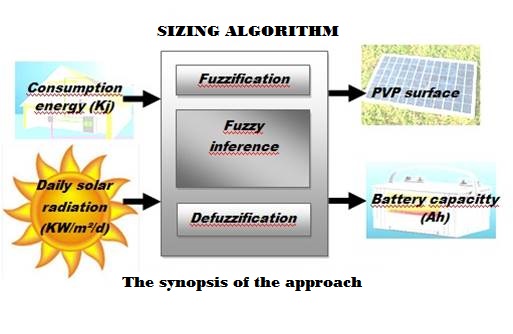Using 'Fuzzy Logic' to Optimize Hybrid Solar/Battery Systems

Chokri BEN SALAH/Control and Energy Management Lab. (CEMLab), Department of Electrical Engineering, National School of Engineers of Sfax, BP. W, 3038, Sfax, Tunisia. This image shows the fuzzy logic algorithm which reads the consumption energy and the monthly average of daily solar radiation and gives the output of the system which is the PVP surface and the battery capacity.
How did fuzzy logic help a group of researchers in Tunisia and Algeria create an ideal photovoltaic system that obeys the supply-and-demand principle and its delicate balance?
In the Journal of Renewable & Sustainable Energy, from AIP Publishing, the group describes a new sizing system of a solar array and a battery in a standalone photovoltaic system that is based on fuzzy logic — a many-valued logic system designed to reason outputs by considering a range of possibilities rather than a simple, binary yes or no, as with classical logic.
“The fuzzy logic system accepts the consumed energy and the monthly average of daily solar radiations as inputs and then outputs photovoltaic panel surfaces and the battery capacity,” explained Chokri Ben Salah, a researcher in the Control and Energy Management Lab in the Department of Electrical Engineering at the National School of Engineers of Sfax, as well as an assistant professor at the Higher Institute of Applied Science and Technology of Sousse in Tunisia.
“Our method applies Matlab/Simulink interfaces, which aren't complicated compared with other forms of simulation and model-based design,” said Ben Salah. In fact, it's possible to build up a graphic integrated user interface to facilitate the usage of the proposed system. The group verified system performance with different inputs by simulations using calculated outputs.
Their results demonstrated the effectiveness of this approach, Ben Salah added. For example, an expansion-planning model of photovoltaic panels and battery systems for a domestic “smart” house performed well in simulations.
The sizing photovoltaic/battery system provides the capacity of batteries used in the hybrid system and determines the surface of the PVP to be used. Its primary significance is “characterized by its simplicity in the usage and its efficiency in optimizing the cost and losses,” they report.
In terms of applications, the system may find use in a number of areas, including domestic dwellings, public buildings and industrial electrical settings, as well as for agricultural water pumping in the field.
What's the next step for the team's work? “An extension of the present system is possible — such as appending a wind or fuel cell energy source,” noted Ben Salah. “Our system can also be improved by adding an electrolyzer system to permit it to convert lost photovoltaic solar energy into hydrogen that can be stored in a special tank and then be used elsewhere.”
The article, “New optimally technical sizing procedure of domestic PVP/Battery system,” is authored by Chokri Ben Salah, Kheireddine Lamamra and Anis Fatnassi. It appears in the Journal of Renewable and Sustainable Energy on Tuesday, February 24, 2015 (DOI: 10.1063/1.4907923). After that date, it can be accessed at: http://scitation.aip.org/content/aip/journal/jrse/7/1/10.1063/1.4907923
The authors of this paper are affiliated with the National School of Engineers of Sfax (Tunisia), University of Bejaia (Algeria), National School of Engineers of Monastir (Tunisia).
ABOUT THE JOURNAL
The Journal of Renewable and Sustainable Energy is an interdisciplinary, peer-reviewed journal produced by AIP publishing that covers all areas of renewable and sustainable energy-related fields that apply to the physical science and engineering communities. See: http://jrse.aip.org/
Contact Information
Jason Socrates Bardi, AIP
jbardi@aip.org
240-535-4954
@jasonbardi
Media Contact
All latest news from the category: Power and Electrical Engineering
This topic covers issues related to energy generation, conversion, transportation and consumption and how the industry is addressing the challenge of energy efficiency in general.
innovations-report provides in-depth and informative reports and articles on subjects ranging from wind energy, fuel cell technology, solar energy, geothermal energy, petroleum, gas, nuclear engineering, alternative energy and energy efficiency to fusion, hydrogen and superconductor technologies.
Newest articles

A universal framework for spatial biology
SpatialData is a freely accessible tool to unify and integrate data from different omics technologies accounting for spatial information, which can provide holistic insights into health and disease. Biological processes…

How complex biological processes arise
A $20 million grant from the U.S. National Science Foundation (NSF) will support the establishment and operation of the National Synthesis Center for Emergence in the Molecular and Cellular Sciences (NCEMS) at…

Airborne single-photon lidar system achieves high-resolution 3D imaging
Compact, low-power system opens doors for photon-efficient drone and satellite-based environmental monitoring and mapping. Researchers have developed a compact and lightweight single-photon airborne lidar system that can acquire high-resolution 3D…





















